The longitudinal transcriptional response to neoadjuvant chemotherapy with and without bevacizumab in breast cancer
Silwal-Pandit, Laxmi; Nord, Silje; Gythfeldt, Hedda; Møller, Elen Kristine; Fleischer, Thomas; Rødland, Einar Andreas; Krohn, Marit; Borgen, Elin; Garred, Øystein; Olsen, Tone; Vu, Phuong Ngoc Thi; Skjerven, Helle; Fangberget, Anne; Holmen, Marit Muri; Schlichting, Ellen; Wille, Elisabeth; Stokke, Mette Norberg; Vollan, Hans Kristian Moen; Kristensen, Vessela N.; Langerød, Anita; Lundgren, Steinar; Wist, Erik; Naume, Bjørn; Lingjærde, Ole Christian; Børresen-Dale, Anne-Lise; Engebråten, Olav
Journal article, Peer reviewed
Accepted version
Permanent lenke
http://hdl.handle.net/11250/2481099Utgivelsesdato
2017Metadata
Vis full innførselSamlinger
Sammendrag
Purpose: Chemotherapy-induced alterations to gene expression are due to transcriptional reprogramming of tumor cells or subclonal adaptations to treatment. The effect on whole-transcriptome mRNA expression was investigated in a randomized phase II clinical trial to assess the effect of neoadjuvant chemotherapy with the addition of bevacizumab.
Experimental Design: Tumor biopsies and whole-transcriptome mRNA profiles were obtained at three fixed time points with 66 patients in each arm. Altogether, 358 specimens from 132 patients were available, representing the transcriptional state before treatment start, at 12 weeks and after treatment (25 weeks). Pathologic complete response (pCR) in breast and axillary nodes was the primary endpoint.
Results: pCR was observed in 15 patients (23%) receiving bevacizumab and chemotherapy and 8 patients (12%) receiving only chemotherapy. In the estrogen receptor–positive patients, 11 of 54 (20%) treated with bevacizumab and chemotherapy achieved pCR, while only 3 of 57 (5%) treated with chemotherapy reached pCR. In patients with estrogen receptor–positive tumors treated with combination therapy, an elevated immune activity was associated with good response. Proliferation was reduced after treatment in both treatment arms and most pronounced in the combination therapy arm, where the reduction in proliferation accelerated during treatment. Transcriptional alterations during therapy were subtype specific, and the effect of adding bevacizumab was most evident for luminal-B tumors.
Conclusions: Clinical response and gene expression response differed between patients receiving combination therapy and chemotherapy alone. The results may guide identification of patients likely to benefit from antiangiogenic therapy.
